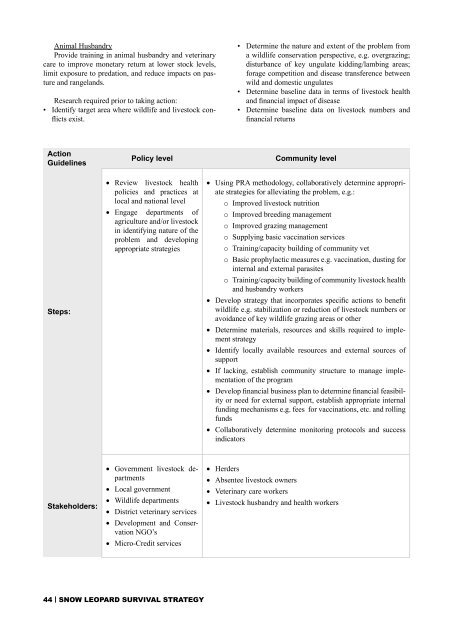Snow Leopard Survival Strategy - Panthera
Snow Leopard Survival Strategy - Panthera
Snow Leopard Survival Strategy - Panthera
You also want an ePaper? Increase the reach of your titles
YUMPU automatically turns print PDFs into web optimized ePapers that Google loves.
Animal Husbandry<br />
Provide training in animal husbandry and veterinary<br />
care to improve monetary return at lower stock levels,<br />
limit exposure to predation, and reduce impacts on pasture<br />
and rangelands.<br />
Research required prior to taking action:<br />
• Identify target area where wildlife and livestock conflicts<br />
exist.<br />
• Determine the nature and extent of the problem from<br />
a wildlife conservation perspective, e.g. overgrazing;<br />
disturbance of key ungulate kidding/lambing areas;<br />
forage competition and disease transference between<br />
wild and domestic ungulates<br />
• Determine baseline data in terms of livestock health<br />
and financial impact of disease<br />
• Determine baseline data on livestock numbers and<br />
financial returns<br />
Action<br />
Guidelines<br />
Policy level<br />
Community level<br />
Steps:<br />
• Review livestock health<br />
policies and practices at<br />
local and national level<br />
• Engage departments of<br />
agriculture and/or livestock<br />
in identifying nature of the<br />
problem and developing<br />
appropriate strategies<br />
• Using PRA methodology, collaboratively determine appropriate<br />
strategies for alleviating the problem, e.g.:<br />
o Improved livestock nutrition<br />
o Improved breeding management<br />
o Improved grazing management<br />
o Supplying basic vaccination services<br />
o Training/capacity building of community vet<br />
o Basic prophylactic measures e.g. vaccination, dusting for<br />
internal and external parasites<br />
o Training/capacity building of community livestock health<br />
and husbandry workers<br />
• Develop strategy that incorporates specific actions to benefit<br />
wildlife e.g. stabilization or reduction of livestock numbers or<br />
avoidance of key wildlife grazing areas or other<br />
• Determine materials, resources and skills required to implement<br />
strategy<br />
• Identify locally available resources and external sources of<br />
support<br />
• If lacking, establish community structure to manage implementation<br />
of the program<br />
• Develop financial business plan to determine financial feasibility<br />
or need for external support, establish appropriate internal<br />
funding mechanisms e.g. fees for vaccinations, etc. and rolling<br />
funds<br />
• Collaboratively determine monitoring protocols and success<br />
indicators<br />
Stakeholders:<br />
• Government livestock departments<br />
• Local government<br />
• Wildlife departments<br />
• District veterinary services<br />
• Development and Conservation<br />
NGO’s<br />
• Micro-Credit services<br />
• Herders<br />
• Absentee livestock owners<br />
• Veterinary care workers<br />
• Livestock husbandry and health workers<br />
44 | SNOW LEOPARD SURVIVAL STRATEGY
















